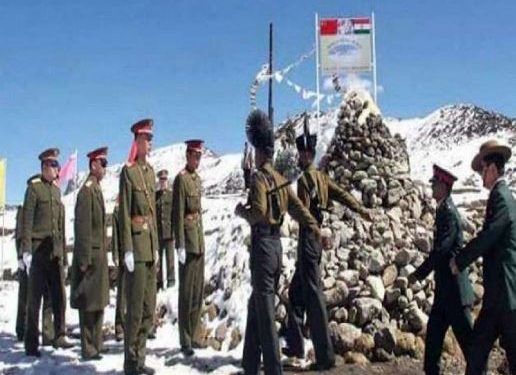Kolkata: India has an established mechanism to resolve any “friction” related to the international border with China in Arunachal Pradesh, GOC-in-Chief, Eastern Command, Lt General Rana Pratap Kalita said Saturday.
To a question about the past disputes between the two countries on the Sino-Indian border issue along Arunachal Pradesh, the senior army officer told reporters that the particular stretch of border is demarcated by the McMahon Line.
“That border is not marked in the same way as the Radcliff Line which demarcates the Indo-Bangladesh border. The Indo-Bangladesh border is demarcated by Radcliff pillars, everyone knows the alignment of those border areas. The Arunachal border is not demarcated in that way, so there can be differing perceptions (between two sides)…However, we have the established mechanism to resolve all such frictions. There are five agreements which guide the way to resolve all such frictions whenever those take place,” Lt Gen Kalita said.
Two days after the country’s independence from British rule in 1947, the Radcliffe Line, a geographical marker was published that demarcated the boundary between India and the newly created dominion of Pakistan.
The senior army officer was in conversation with Air Chief Marshal (Retd) Arup Raha and members of Bharat Chamber of Commerce, Kolkata on security-related issues.
China claims Arunachal Pradesh as South Tibet which is firmly rejected by the External Affairs Ministry which has asserted that the state is an “inseparable part of India”. Beijing routinely protests visits of top Indian leaders and officials to Arunachal Pradesh to reaffirm its claim.
Asked about the threat perception along the Siliguri Corridor or Chicken’s Neck in north Bengal in the wake of the Indo-China Doklam crisis in 2017, Lt Gen Kalita said “we are conscious about the importance of the Siliguri Corridor to the nation as it connects the entire Northeast with the rest of the country and the narrowest part of it is only 20 km.
“…we have friendly relations with Bangladesh, Nepal, and Bhutan. But the distance from the tip of the corridor to the Chinese territory is over 40 km. We are conscious of the type of threat…..Requisite steps are being taken from the security point of view.”
The Siliguri Corridor is a narrow stretch of land bordering Nepal, Bhutan, and Bangladesh measuring approximately 170×60 km.
Asked about the Russia -Ukraine conflict, the senior officer said the armed forces and the government of India are aware of the developments and only time can say how it will further manifest itself.
“India is conscious of the dimensions of possibilities, lots of steps have been taken to address the concerns of both sides …Our doctrines have also been reviewed,” he said.
The Lt General said Indian armed forces have also recently ensured “our capability enhancement takes place to cope with any type of challenge from any quarters. We are prepared to face contingencies…Our doctrines have also been reviewed.”
On the ‘Look East’ and ‘Act East’ policy in the last couple of decades, he said as the first step to bringing peace and stability, there is a need for development and improving connectivity.
“For any sort of development, progress (the) first requirement is connectivity. One way to take forward the Look East policy is infrastructure development. We all need to contribute,” he said, adding the infrastructure network has improved greatly in the region.
“The second issue is that of connecting with our neighbours and our armed forces are playing a big role. We have a rapport with the Myanmar army despite a problem persisting there now. We also have excellent ties with Bangladesh,” he said.
He said the Look East, Act East policy entails conceptualising and implementing various steps and promises, policies, and projects which should be taken forward.
On the repeal of the Armed Forces Special Powers Act from the entire Northeastern region, he said “it is not a constant thing. It is a dynamic process that is reviewed based on the situation and the ground reality, based on vital parameters. AFSPA has been totally withdrawn in many districts in certain states and partially in some other districts (in the northeast). Such decisions are based on the improvement in the ground situation. Wherever the situation has improved, AFSPA is withdrawn.”
On the recent agitation and controversy surrounding the Agnipath scheme, he said “any new, big change coming in does take some time to settle in”.
In June this year, the Agnipath scheme, relating to the recruitment of soldiers into the Army, the Navy, and the Air Force on a short-term contractual basis was unveiled.
Pointing out that there can be “teething issues” about implementing the scheme, he said “it is a very good step. The biggest advantage is it is going to bring down the average age of soldiers from 32 to 26 considering the young profile of our people. We are bringing down the average age by six years thus giving opportunities to more and more people to serve the country”.
He said this would instil nationalism and an ethos of discipline. This project will churn out more technologically enabled army personnel as Agniveers.
“There will be more number of qualified people who will assimilate technology. If more qualified people, disciplined youth get the opportunity to become disciplined motivated soldiers that is good. After four years they can be part of police forces, CRPF, armed police, and in the industry (security),” he said.
Only some basic issues remain, “which need to be overcome,” he added.
Asked about the situation in Jammu and Kashmir, the Eastern Command army head said “people in Kashmir want peace and stability. The government is undertaking people-centric, socio-economic development in the region.”
PTI






































